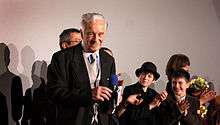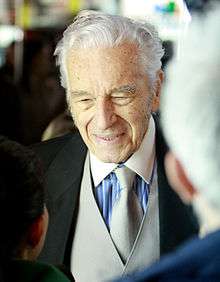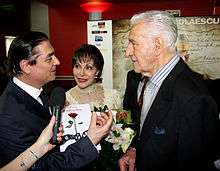Sergiu Nicolaescu
| Sergiu Nicolaescu | |
|---|---|
|
Sergiu Nicolaescu in 2009 | |
| Born |
Sergiu Florin Nicolaescu 13 April 1930 Târgu Jiu, Romania |
| Died |
3 January 2013 (aged 82) Elias Hospital, Bucharest, Romania |
| Nationality | Romanian |
| Occupation | |
| Years active | 1962–2013 |
Sergiu Florin Nicolaescu (Romanian: [ˈserd͡ʒju nikolaˈesku]; 13 April 1930 – 3 January 2013) was a Romanian film director, actor and politician. He was best known for his historical films, such as Mihai Viteazul (1970, released in English both under the equivalent title Michael the Brave and also as The Last Crusade), Dacii (1966, Les Guerriers), Razboiul Independenței (1977, War of Independence), as well as for his series of thrillers that take place in the interwar Kingdom of Romania, such as Un comisar acuză (1973, A Police Inspector Calls). Joanna Pacuła starred in his film Ultima noapte de dragoste (The Last Night of Love) in 1979 before eventually emigrating to the U.S. where she went on to very successful career.[1]
He died following surgical complications of peritonitis which led to cardiac arrest.[2]
Early life and education
Sergiu Nicolaescu was born in Târgu Jiu, but grew up in Timişoara, where his family moved when he was 5 years old. He graduated from the Polytechnic University of Bucharest as a mechanical engineer. After graduation he started to work as a camera operator. He was hard-working, well-organized, curious, intelligent and keen of learning. During these years he acquired many of the skills that have proved so useful when making his later movies.
Film director, writer and actor
Sergiu Nicolaescu was considered during his lifetime, as he is now, the most popular, loved and prolific Romanian movie director. His overwhelming film career spanning 55 years, leaves us today his legacy of some 60 movies, for the making of which he used to act at times, simultaneously, as film director, as an actor, and the writer/screenplayer. In his native Romania he is remembered as a superstar for his patriotism, the high praise he gained as a film director, and his charismatic and strong personality.
Nicolaescu's debut as a director was in 1962 with the short film Scoicile nu au vorbit niciodată (Shells Have Never Spoken). His first feature film was the 1967 French-Romanian co-production Dacii (Les Guerriers). The film was entered into the 5th Moscow International Film Festival.[3] Nicolaescu continued his film-making career by both directing a large number of movies and starring in many of his own films. His 1971 film Mihai Viteazul was entered into the 7th Moscow International Film Festival.[4] As an anecdotal detail, in Steven Spielberg's E.T. The Extraterrestrial (original version only), the young boy Elliott watches this movie on TV - Mihai Viteazul in the US version - the scene with the battle of Calugareni. His 1976 film The Doom was entered into the 10th Moscow International Film Festival.[5]
Mihai Viteazul (Michael the Brave) ruled the Romanian-speaking principalities (Wallachia, Moldavia and Transylvania), a union he accomplished under his reign for a very brief period (1600–1601). It was initially planned that Sergiu Nicolaescu would produce Mihai Viteazul with Hollywood superstars playing the lead characters. The communist authorities of the time drastically ruled for an all Romanian cast. The obstacle, eventually, was circumvented by means of casting, in the lead role of Mihai Viteazul the actor Amza Pellea who achieved a masterful rendition of the hero. Sergiu Nicolaescu was able, throughout his career, to select the best actors available for the characters they had to portray.
Most of Nicolaescu's films are built around figures and events in Romanian history, and although showing superior mastery, in the (imposed) realistic approach they somewhat follow the patterns of historical movies from the Communist governed countries. During the Communist period, some of these movies were seen as ground-breaking through either their way of publicly presenting Romanian history, or the masterful depiction of the heroical dimension of its history. For instance, the movie "Războiul independenţei" was the first picture made during the Communist-era in Romania to describe a Romanian king (namely Carol I) in a positive fashion. On the other hand, Mircea (1989, also known as Proud Heritage) was considered by some critics as being a less artistically fulfilled endeavour. Nevertheless, Mircea was officially blocked from distribution, until the Romanian Revolution of 1989 ("All I've done was to present a different state leader than Nicolae Ceauşescu. He understood and stopped the movie [from premiere]").[6] Yet, when Mircea was finally released to the public the film was very well appreciated.


Sergiu Nicolaescu produced impeccable renderings of the historical battles and costumes. For example, through his reenactments of the Battle of Călugăreni in Mihai Viteazul and both the Crusade of Nicopole and the Battle of Rovine in Mircea, Nicolaescu shows a brilliant command of his craft, masterfully directing a huge acting crew (actors, extras, etc.) towards the rendering of accurate details, by these means forging widely successful movies. For instance, when making Mihai Viteazul, Nicolaescu successfully managed a 5,000-member crew, actors and extras and, despite the obvious technical limitations of the communication means in the 1970s (no mobile phones were available at that time, for instance), he imposed a strict discipline during filming of every cannon fire and every attack scene, thus helping everything to fall in place under his unique order.
His movie Mihai Viteazul was considered the best of the Romanian historical movies and is one of the most appreciated world-wide of this kind (for example, considering imdb ratings) . The film was released in 1970 in Romania, and worldwide by Columbia Pictures as The Last Crusade. A TV sequence in Steven Spielberg's "E.T." (original, uncut version) show images from "Mihai Viteazul" (scenes with the Battle of Calugareni).
While creating such historical movies he was supported by the Romanian Ministry of Defence with large numbers of extras and war equipment. He documented his historical movies meticulously, to this end seeking the advice of military consultants and distinguished historians of the Romanian Academy. Regardless these films have aesthetic qualities too, and are the expression of Sergiu Nicolaescu's vision as both a film director and a writer.
His 1985 film The Ring was entered into the 14th Moscow International Film Festival.[7] For this movie, Nicolaescu performed a very intensive boxing training with a former European boxing champion. The intensity of his training for this movie was similar to what the Romania's Olympic boxing team at that moment performed. At that time Nicolaescu was 50 years old and its boxing matches and the hits during this movie are real and against strong opponents.
His huge work capacity was widely admired by his colleagues and crew. Another merit of his filmmaking is considered to come from his taking huge - yet, still well-calculated - risks while filming. For instance, for the war scenes, he used real dynamite and trotyle as well as real blood. In such situations there was always a high likeliness of the actors or the camera operators being afraid to fulfill their tasks. It was a big merit of Sergiu Nicolaescu that, for all difficult or very risky tasks, he was able to show in detail to any actor or camera operator exactly what they had to do before they did it. In such circumstances, during his 50 years career as film director and actor, Nicolaescu experienced several accidents or illness: still he went on performing and finished his movie projects with courage and sometimes at great personal cost (e.g., while producing Mihai Viteazul).
After Mircea, Nicolaescu expands on historical themes, directing films that shed positive light on Ion Antonescu, Romania's Axis-aligned dictator in the World War II period (his Începutul adevărului, also known as Oglinda), or glorified the World War I heroine Ecaterina Teodoroiu (Triunghiul morţii, also known as Triangle of Death).

An accomplished battle scenes director, Sergiu Nicolaescu, as legend has it, would have been able to film some 70–80 meters of useful shots in the same amount of time that the average director would need in order to produce 12–15 meters.[8]
Although his last films were not as popular as his earlier productions, he continued to direct new films, such as Orient Express (2004) or Cincisprezece (2005), a love story set during the Romanian Revolution of 1989, Supravietuitorul (2008), Carol I (2009) and Poker (2010).
When asked to nominate three movies he made that he most liked, Nicolaescu chose Mihai Viteazul (also known as Michael the Brave), Osanda (also known as The Doom) and Atunci i-am condamnat pe toti la moarte (also known as Then I Sentenced Them All to Death).
Politician
Sergiu Nicolaescu started his political career during the 1989 Romanian Revolution. At the time the Revolution took place he was very well known and respected for his films, in Romania. He participated actively at the Romanian Revolution and his appearance and speech during the Revolution brought about coherence and clarity to the people who listened. In December 1989 he was received with a standing ovation (his name) from the crowd of hundreds of thousands of Romanians gathered in the heart of Bucharest after Nicolae Ceaușescu left power on 22 December 1989. He called for calm asked the crown to listen to and support Ion Iliescu. Sergiu Nicolaescu went on playing an important political role during the Revolution and was elected to the Romanian Senate in 1992 as a member of the Romanian Social Democratic Party. He left the party in April 2011,[9] and then rejoined it after only two days.[10]
In 2005 Nicolaescu declared in an interview that he was not happy with his decision of going into politics. He felt that the politics took too much from his precious time and because of that he was not able to do as many films as before the Revolution.
Personal life
Sports and personal life
Sergiu Nicolaescu said that as a young boy, he practiced many sports like athletics, equestrianism, boxing, shooting and rugby. According to the public information available, Nicolaescu was a very active person and he had a very disciplined lifestyle. Every day, even he was 80 years old, he spent at least 1 hour doing physical activity (gimnastics, etc.).
Although he was never a very passionate football fan, Nicolaescu stated in a 2011 interview for the Romanian daily sports newspaper Gazeta Sporturilor that the Bucharest team F.C. Steaua was the dearest to him throughout time, even though he played rugby at Dinamo.[11] He explained this by saying that he liked the former Steaua legends Hagi, Bölöni and Petrescu more than Dinamo's player. Nicolaescu declared in the same interview that he also liked Ripensia and "U" Craiova in their glory days, but not as much as Steaua.
Sergiu Nicolaescu was married three times. He did not have children and this was his main regret.
Failing health and death
Sergiu Nicolaescu had been diagnosed since 2000 with diverticulitis, a benign and chronic digestive condition that was acting up every couple of years. In January 2008 he twice suffered a brain surgery because of an accident. At that time, he was 78 years old. The doctors did not give him any change of success because at the time of first brain operation he was completely paralyzed. He had to learn again to walk, speak and write and he successfully managed to do it after 3 months of intense gymnastics and brain exercises. Nevertheless after this brain surgeries he said he changed dramatically: he started feeling his age and he started changing his behaviour (more impatient and nervous). In his last years the health problems made his life difficult. Yet he continued directing, acting and planning new films. He maintained intact his huge passion for filmmaking until the end of his life.
On 26 December 2012 he was admitted with atrial fibrillation and a traumatised thorax with pulmonary contusion at the Elias Hospital in Bucharest, he was complaining of pain in the lower abdomen and loss of appetite. After the clinical examination, the doctors concluded that he was suffering from an acute episode of diverticulitis, and he received treatment for this conditions. During the treatment, Nicolaescu's condition improved, but the intestinal transit was not functional and the blood work was still unsatisfactory. The doctors opted for an exploratory laparoscopy, which led to the discovery of an acute perforated appendicitis complicated with peritonitis. After undergoing surgery, Nicolaescu developed respiratory complications, leading to acute respiratory failure within 48 hours. He entered into cardiac arrest on 3 January 2013, and could not be resuscitated by the hospital staff. He was pronounced dead at 8:20 AM GMT+2.[12] His body was cremated on 5 January 2013, according to his wishes.
Feature films
- Dacii – 1967
- Lupta pentru Roma (co-director Robert Siodmak) – 1968
- Ciorap de piele (co-director Pierre Gaspard-Huit) – 1968
- Ultimul mohican – 1968
- Lacul din Ontario – 1968
- Preeria – 1968
- Mihai Viteazul – 1970
- Atunci i-am condamnat pe toţi la moarte – 1972
- Cu mâinile curate - 1972
- Lupul mărilor (co-director Wolfgang Staudte) – 1972
- Răzbunarea – 1972
- Ultimul cartuş – 1973
- Un comisar acuză – 1974
- Nemuritorii – 1974
- Insula comorilor – 1975
- Piraţii - 1975
- Zile fierbinţi – 1975
- Osânda – 1976
- Accident – 1976
- Războiul independenţei (Pentru patrie) (co-directors Doru Năstase, Gh. Vitanidis) – 1977
- Revanşa – 1978
- Nea Mărin miliardar – 1978
- Mihail, câine de circ – 1978
- Ultima noapte de dragoste – 1979
- Capcana mercenarilor – 1980
- Duelul – 1981
- Întâlnirea – 1982
- Viraj periculos – 1982
- Ringul – 1983
- Căutatorii de aur – 1984
- Ciuleandra – 1985
- Ziua Z – 1985
- Noi, cei din linia întâi – 1986
- François Villon (film) – 1987
- Mircea – 1989
- Coroana de foc – 1990
- Cucerirea Angliei – 1990
- Începutul adevărului – 1993
- Punctul zero – 1996
- Triunghiul morţii – 1999
- Orient Express – 2004
- Cincisprezece – 2005
- Supravieţuitorul – released on April 11, 2008
- Carol I (film) – released on May 9, 2009
- Poker (film) – 2010
- Ultimul Corupt din România (film) – 2012
References
- ↑ "Ultima noapte de dragoste (1979)". IMDb. 13 January 2013. Retrieved 13 January 2013.
- ↑ http://www.gandul.info/news/explicatiile-medicilor-dupa-decesul-lui-sergiu-nicolaescu-a-fost-stop-cardiac-10424799
- ↑ "5th Moscow International Film Festival (1967)". MIFF. Retrieved 2012-12-09.
- ↑ "7th Moscow International Film Festival (1971)". MIFF. Retrieved 2012-12-23.
- ↑ "10th Moscow International Film Festival (1977)". MIFF. Retrieved 2013-01-13.
- ↑ "Filme lung metraj - Mircea - 1989 - Studioul Bucureşti". Sergiu Nicolaescu. Archived from the original on April 15, 2008.
- ↑ "14th Moscow International Film Festival (1985)". MIFF. Retrieved 2013-02-17.
- ↑ "Sergiu Nicolaescu - Biography". The Internet Movie Database. Retrieved 19 September 2011.
- ↑ "Sergiu Nicolaescu şi-a dat demisia din PSD" ("Sergiu Nicolaescu Resigns from PSD") (in Romanian). Adevărul, 19 April 2011; accessed April 19, 2011
- ↑ (Romanian) "Sergiu Nicolaescu s-a întors în PSD: 'Bună ziua, mă iertaţi!'" ("Sergiu Nicolaescu Returns to PSD: 'Hello, Forgive Me!'"), Jurnalul Naţional, 20 April 2011; accessed January 3, 2013
- ↑ (Romanian) "Am fost rugbyst la Dinamo, dar ţineam cu Steaua" (I was a rugby player at Dinamo, but I liked Steaua"), Gazeta Sporturilor, 4 October 2011; accessed January 3, 2013
- ↑ http://www.rtv.net/nicolaescu-a-fost-tratat-timp-de-12-ani-pe-pentru-mai-multe-complicatii-ale-bolii-diverticulare_60263.html
External links
- Official website
- Sergiu Nicolaescu at the Internet Movie Database
- Interview Sergiu Nicolaescu
- Interview audio Sergiu Nicolaescu